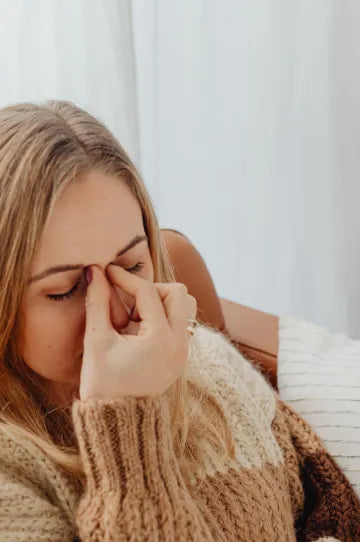




What are you looking for?

Dust allergy remedies that actually help—reduce sneezing and blocked nose with easy home steps, HEPA cleaning, hot-wash bedding, humidity control, and gentle Ayurvedic support.
Blocked nose, sneezes, itchy eyes—if dust at home sets you off, you’re not alone. The good news: dust allergy remedies can be simple, low-cost, and very effective when you do a few things together. This guide shows exactly what to do today, what to keep weekly, and how gentle Ayurveda may support you—without harsh claims.
Control humidity, hot-wash bedding, zip mattresses, clean right, rinse nose, and breathe easier.

Most trouble comes from dust mites—tiny creatures living in mattresses, pillows, carpets, and sofas. It’s not the mites but their droppings (proteins) that spark allergy symptoms. They love warm, humid rooms and fabric surfaces. Keeping them low needs a multi-step plan, not one gadget. WHO notes that higher indoor dampness/humidity supports mites and worsens symptoms. (World Health Organization)
Here’s the simple, proven bundle. Do as many as you can together for better relief. Research reviews highlight multifaceted bedroom control—encasements + hot washing + good cleaning—as effective parts of a plan. (PubMed)

Use exhaust fans in kitchens/bathrooms.
Ventilate daily; fix leaks; avoid indoor drying of clothes if possible.
Dehumidifier or AC “dry mode” in very humid months.
Keeping indoor humidity under ~50% reduces mite levels and symptoms. (salud-ambiental.com)
Wash sheets, pillowcases, and duvet covers at ≥60 °C.
Dry fully in sunlight or a hot dryer.
Heat kills mites and removes allergen proteins that trigger reactions. (NCBI)
Use allergen-proof encasements for mattresses, pillows, and even duvets.
If possible, replace very old pillows/mattresses.
Bedroom encasements are a core control step in dust-mite avoidance strategies. (PubMed Central)
Vacuum mattresses, sofas, and carpets with a HEPA vacuum.
Damp-dust with a microfiber cloth (dry dusting just spreads particles).
Prefer hard flooring in bedrooms; reduce heavy curtains/soft toys.
Better cleaning plus filtration lowers mite and pet allergens in indoor air. (PubMed Central)
Use sterile/boiled-then-cooled water + isotonic saline.
Rinse once daily during flare-ups; stop if you feel irritation.
Saline rinses can ease nasal blockage and wash out allergens. (General evidence base; practice safely and hygienically.)
Choose a purifier sized for your room with a true HEPA filter.
Keep doors/windows mostly closed while running it; change filters on schedule.
Purifiers reduce airborne allergen loads; still, do them with the cleaning/humidity steps. (PubMed Central)
In most Indian cities (often humid), skip routine humidifier use. If your air is very dry in winter, use carefully and keep RH ≤50% to avoid helping mites. (World Health Organization)
Mites hide inside fabrics and foam. That’s why dust allergy remedies work best in layers: reduce humidity (they can’t thrive), remove reservoirs (encase, hot-wash), and cut airborne spread (HEPA cleaning/purifying). Reviews of home interventions consistently support multifaceted strategies over single fixes. (PubMed)
Morning: Strip bed, bag linens, start hot wash (≥60 °C).
Noon: Vacuum mattress and pillows (slow passes), encase them, put on clean bedding.
Afternoon: HEPA-vacuum carpets/sofa; damp-dust all reachable surfaces.
Evening: Ventilate 15–20 minutes; set AC/dehumidifier to keep RH ≤50%.
These simple dust allergy remedies cut the biggest mite sources in 24 hours. (salud-ambiental.com)
Along with the basics, many people find relief with steam inhalation (plain water), saline rinses, warm showers at night, and keeping bedrooms uncluttered. In Ayurveda, gentle nasya (medicated nasal oil) is traditionally used under guidance for allergic rhinitis; early clinical and protocol papers suggest potential benefit, but it should be supervised by a qualified practitioner.
Wheeze, tight chest, or breathlessness
Persistent symptoms >2–3 weeks despite dust allergy remedies
Recurrent sinus infections, fever, or facial pain
Children with disturbed sleep, poor appetite, or school issues
A doctor may suggest antihistamines, nasal steroids, or allergy testing; some patients benefit from immunotherapy (under specialist care).
At Amiy Naturals, we aim to support your body’s balance, not “cure” allergies. Our approach explains complex ideas simply:
Supports calm, balanced nerve signalling—useful when sneezing/itch cycles feel “over-triggered”.
Synergistic botanicals chosen to gently support breathing comfort, sleep quality, and overall resilience.
If you’re exploring Ayurvedic options like nasya, do it with a qualified practitioner—especially for children, pregnancy, or chronic sinus issues. (Lippincott Journals)
This content is for education only and is not a substitute for professional medical advice. Please consult a qualified healthcare provider for personal care.
Hot-wash bedding (≥60 °C) weekly, zip mattresses/pillows, and keep bedroom humidity ≤50%. Add HEPA-vacuuming and damp-dusting when you can. (salud-ambiental.com)
Helpful, not magic. They reduce airborne particles but don’t remove mites inside fabrics. Combine with hot-wash and encasements for best results. (PubMed Central)
Only if air is very dry; otherwise higher humidity helps mites. Keep RH ≤50% if you use one. (World Health Organization)
It may help some people, but do it under professional guidance; evidence is emerging. Avoid DIY in kids or during infections. (Lippincott Journals)
Many feel easier breathing within 1–2 weeks of consistent dust allergy remedies (washing, encasing, cleaning, humidity control). Individual results vary.
If nighttime allergy ruins your sleep, pair these dust allergy remedies with gentle support. Explore Tranquil Tonic for calmer nights and Gut Reset to support overall resilience—both are doctor-formulated and 100% natural. Use them alongside your home controls; they don’t replace medical care.
You can also search for: Acne Remedies Simple Safe Home Solutions | Ayurvedic Remedies For Menstrual Cramps | Back Muscle Cramps Remedies | Best Natural Remedies Acid Reflux Elderly | Blocked Nose Remedies Breathe Easy Fast | Dry Skin Remedies Simple Natural Fixes That Work | Female Bloated Stomach Remedies | Herbal Remedies For Anxiety Calm Mind Better Sleep | Muscle Tear Remedies | Natural Herbal Remedies | Natural Remedies For Acid Reflux Simple Fixes That Work | Natural Remedies For Anxiety During Pregnancy Safe Tips | Natural Remedies For Gas And Bloating | Natural Remedies For Menstrual Pain | Natural Remedies For Rheumatoid Arthritis | Natural Remedies For Sciatica Simple Relief Tips | Natural Remedies For Swelling After Surgery | Natural Remedies Psoriasis | Neck Pain Remedies Quick Safe Relief At Home | Neem Benefits A Natural Remedy For Your Skin And Health | Remedies For Leg Cramps | Remedy For Muscle Cramps | Sciatica Natural Remedies Easy Relief At Home | Stiff Neck Remedies | Stomach Infection Remedies Safe Relief At Home